What is potassium sorbate – E202?
Potassium sorbate, E220, is a food additive that belongs to the category of preservatives.
Read too:E551 – Silicon dioxide
Its chemical formula is potassium hexa-2,4-dienoate or the potassium salt of trans, trans,-hexa-2,4-dienoic acid. Its crude formula is C6H7O2K and its molecular mass is M=150,22 g/mol/

For industrial use it is obtained by treating sorbic acid with hydroxide or potassium carbonate. It is the potassium salt of sorbic acid E 200.
It is a white crystalline powder which does not change its colour after 90 minutes heating at 1050C. It has a melting temperature of 133-1350C and its solubility in water at 250C is 1380 g/l.
The effectiveness of the active form is 74.6% at pKa=4.8. The food additive must contain a minimum of 99% active substance relative to dry matter, aldehydes maximum 0.1% expressed as formaldehyde, loss on dehydration maximum 1% (at 1050C for 3 hours), and acidity 1% expressed as ascorbic acid.
It is a good preservative especially against moulds and yeasts, but not effective against bacteria. It shows optimal activity at pH below 6.5 (acid and slightly acid products).
Sorbates are also used in combination with benzoates in products such as non-alcoholic flavoured drinks (soft drinks), weak alcoholic drinks, liquid tea concentrates (used in dispensers), some preserved fruit and vegetable products, low sugar jams and jellies, olives and olive-based products, fish products, crustaceans, shrimps, molluscs, emulsified and non-emulsified sauces, spices, spices, mustard, prepared salads, non-heat-treated dairy-based desserts, when preserving eggs in liquid form, in dietary foods for special medical purposes, liquid food supplements and chewing gum.
Read too:E950 Acesulfame K
Which foods contain the food additive E202
Potassium sorbate or E202 can be found in the following foods:
– non-alcoholic flavoured drinks (soft drinks);
– weak alcoholic drinks, potassium sorbate is used to preserve the taste of wine. It stops the fermentation process;
– low-sugar jams and jellies;
– some preserved fruit and vegetable products;
Read too:E122 – Azorubine
– olives and olive-based products;
– fish products;
– shellfish, prawns, molluscs;
– emulsified and non-emulsified sauces;
– condiments, spices;
– mustard;
– prepared salads;
– desserts based on non-heat-treated dairy products;
– in dietary foods for special medical purposes, liquid dietary supplements;
– liquid tea concentrates (used in dispensers);
Read too:E407 – Caragenan
– chewing gum.
Where else can potassium sorbate – E202 be found?
According to comparative studies carried out by InfoCons over 6 years (2015-2021) on 60 egg dye products, potassium sorbate (food additive E202) was found in 19 of the egg dye products “analysed”. So, potassium sorbate (food additive E202), can be ranked as one of the most used food additives in the composition of egg dye products. In addition to potassium sorbate (food additive E202), sodium benzonate (food additive E211) appears in 23 of the products whose labels were analysed.
Another study carried out by InfoCons, this time on margarine-type products, identified the presence of potassium sorbate (E202). In addition to E202 (potassium sorbate), the following food additives appear in margarine: curcumin (E100), a synthetic colouring agent, which can lower blood sugar levels; synthetic colouring agent obtained from genetically modified organisms (E160b); synthetic emulsifier (E476), which can have a moderate toxic effect and cause allergies.
Are there any side effects from consuming the food additive E202?
Following consumption of the food additive E202, sporadic adverse reactions such as allergic reactions such as allergic erythema, pseudo-allergic and dermatitis may occur.
What are the characteristics of potassium sorbate – E202?
Maximum daily intake/body: 25 – 1000 mg/kg
Maximum Daily Intake: The Acceptable Daily Intake for cumulative human consumption of sorbic acid and its potassium and calcium salts is up to 25 mg/kg body, at which no side effects have been reported. This is a low dose, which can easily be exceeded, especially by eating a lot of bread (500g bread contains 1000 mg sorbate, the maximum dose for a person weighing 40 kg).
Read too:E 211 – Sodium Benzoate
Intake dose in food: 200-2000 mg/kg
Intake dose in food: It is allowed to be used in amounts between 200 mg/kg and 2000 mg/kg in almost all types of food.
The maximum amount of 2000 mg/kg is used in processed cheese, potato dough and pre-cooked potato slices, sliced bread and other bakery and pastry products, doughs, emulsified sauces, meat substitutes, fish, protein-based cheese, crayfish, shellfish and mollusc products.
What are food additives?
According to the World Health Organisation, substances that are added to food to maintain or improve the safety, freshness, taste, texture or appearance of food are known as food additives. For centuries, food additives have been used to preserve food, for example salt (in meat, bacon or dried fish), sugar (in marmalade) or sulphur dioxide (in wine).
Over time, many food additives have been developed to meet the needs of food production, because large-scale food manufacturing is much more complex than small-scale home production.
The introduction of additives into food is done with the aim of ensuring that processed foods remain safe and in good condition throughout their journey from factories or industrial kitchens to warehouses and shops, and finally to consumers.
Read too:E415 – Xanthan Gum
The use of food additives is only justified when their use has a technological need, does not mislead consumers and serves a well-defined technological function such as preserving the nutritional quality of the food or enhancing the stability of the food.
Food additives may be derived from plants, animals or minerals or may be synthetic. They are intentionally added to food to fulfil certain technological purposes. There are several thousand food additives in use, all of which are designed to perform a specific task, usually to make food more durable or appealing.
How many categories do food additives fall into?
The WHO, together with the FAO, groups food additives into 3 broad categories:
- Flavour enhancers – These are added to foods to improve flavour or taste. Flavour enhancers are the most commonly used of the additives used in food. There are hundreds of types of flavourings used in a wide variety of foods, from confectionery and soft drinks to cereals, cakes and yoghurt.
- Enzyme preparations – These can be obtained by extraction from plants or animal products or from micro-organisms such as bacteria. Enzyme preparations are mainly used in baking (to improve dough), fruit juices, wine making and brewing (to improve fermentation) and cheese making.
Read too:E129 – Alura AC
- Other additives – These are used for several reasons, such as: preservation, colouring and sweetening. They are added when food is being prepared, packaged, transported or stored and eventually become a component of the food.
How are food additives assessed according to risk?
The World Health Organization, in cooperation with the Food and Agriculture Organization of the United Nations (FAO), are responsible for assessing the risks that may arise from the consumption of food additives. The risk assessment of food additives is carried out by an international scientific panel of experts.
Only food additives that have undergone a JECFA safety assessment and do not pose a health risk to consumers may be used. This applies regardless of whether the food additives come from a natural or synthetic source. JECFA assessments are based on scientific analysis of all relevant biochemical, toxicological and other data on a given additive.
National authorities, either on the basis of JECFA assessment or on the basis of a national assessment, can then authorize the use of food additives.
The starting point for determining whether a food additive can be used without harmful effects is establishing the acceptable daily dose. The recommended daily intake is an estimate of the amount of additive in food or drinking water that can be safely consumed daily over a lifetime without adverse health effects.
How do we know food contains food additives?
According to the World Health Organization, practices, standards and guidelines on food labelling are established globally. These standards are implemented in most countries and food manufacturers are obliged to indicate which additives are in their products. In the European Union, for example, there is legislation governing the labelling of food additives according to a set of pre-defined “E-numbers”. People with allergies or sensitivities to certain food additives should read labels carefully.
The World Health Organisation encourages national authorities to monitor and ensure that food additives in food and beverages produced in their countries comply with the uses, conditions and legislation.
Conclusions and Legislative Regulations – E202
Potassium sorbate or E202 is a food additive that can be found in a variety of food products. This food additive can cause adverse reactions such as allergies.
Potassium sorbate or E202 is regulated under European legislation and European Regulation 2018/1497.
Bibliographical references
- https://www.who.int/news-room/fact-sheets/detail/food-additives
2.https://www.fao.org/fao-who-codexalimentarius/sh-proxy/ar/?lnk=1&url=https%253A%252F%252Fworkspace.fao.org%252Fsites%252Fcodex%252FStandards%252FCXS%2B192-1995%252FCXS_192e.pdf
3.Regulation (EC) No 1333/2008 of the European Parliament and of the Council https://eur-lex.europa.eu/legal-content/RO/TXT/PDF/?uri=CELEX:02008R1333-20160525&from=FR
- Elena Oranescu, Food additives-necessity and risk, SemnE Publishing, 2005, Bucharest, p. 146;
- Opinion on the follow-up of the re-evaluation of sorbic acid (E200) and potassium sorbate (E202) as food additives, ADOPTED: 30 January 2019
- COMMISSION REGULATION (EU) 2018/98 of 22 January 2018 amending Annexes II and III to Regulation (EC) No 1333/2008 of the European Parliament and of the Council and the Annex to Commission Regulation (EU) No 231/2012 as regards calcium sorbate (E 203)
- SorbatuBy Commons, CC BY-SA 3.0, https://commons.wikimedia.org/w/index.php?curid=1788086l potassium – E202
- https://pixabay.com/ro/photos/gem-fructe-borcane-gemuri-de-fructe-428094/
- https://pixabay.com/ro/photos/canapea-somon-aperitiv-biscuiti-2802/
Author: dr. ing. Fulvia Ancuța Manolache

